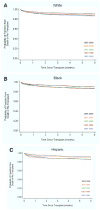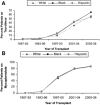Improved survival in heart transplant recipients in the United States: racial differences in era effect
- PMID: 21228316
- PMCID: PMC4256951
- DOI: 10.1161/CIRCHEARTFAILURE.110.957829
Improved survival in heart transplant recipients in the United States: racial differences in era effect
Abstract
Background: Posttransplant survival in heart transplant recipients has progressively improved during the past 2 decades. It is unknown, however, whether the major racial groups in the United States have benefited equally.
Methods and results: We analyzed all primary heart transplant recipients aged ≥18 years in the United States from 1987 to 2008. We compared posttransplant survival in white, black, and Hispanic recipients in 5 successive eras (1987 to 1992, 1993 to 1996, 1997 to 2000, 2001 to 2004, 2005 to 2008). Early survival was defined as freedom from death or retransplantation during the first 6 months posttransplant. Longer-term, conditional survival was assessed in patients who survived the first 6 months. There were 29 986 (81.6%) white, 4745 (12.9%) black, and 2017 (5.5%) Hispanic patients in the study cohort. Black patients were at increased risk of early death or retransplant (hazard ratio [HR], 1.15; 95% CI, 1.05 to 1.26) in adjusted analysis. Early posttransplant survival improved (HR, 0.83; 95% CI, 0.80 to 0.87 for successive eras) equally in all 3 groups (black-era interaction, P=0.94; Hispanic-era interaction, P=0.40). Longer-term survival improved in white (HR, 0.95; 95% CI, 0.92 to 0.97 for successive eras) but not in black (HR, 1.04; 95% CI, 0.99 to 1.09) or Hispanic (HR, 1.02; 95% CI, 0.95 to 1.09) recipients, resulting in increased disparities in longer-term survival with time.
Conclusions: Early posttransplant survival has improved equally in white, black, and Hispanic heart transplant recipients. Longer-term survival has improved in white but not in black or Hispanic recipients, resulting in a more marked disparity in outcomes in the current era. These disparities warrant further investigation and targeted interventions.
Figures



References
-
- Taylor DO, Edwards LB, Aurora P, Christie JD, Dobbels F, Kirk R, Rahmel AO, Kucheryavaya AY, Hertz MI. Registry of the International Society for Heart and Lung Transplantation: twenty-fifth official adult heart transplant report--2008. J Heart Lung Transplant. 2008;27:943–956. - PubMed
-
- Taylor DO, Stehlik J, Edwards LB, Aurora P, Christie JD, Dobbels F, Kirk R, Kucheryavaya AY, Rahmel AO, Hertz MI. Registry of the international society for heart and lung transplantation: twenty-sixth official adult heart transplant report-2009. J Heart Lung Transplant. 2009;28:1007–1022. - PubMed
-
- Marelli D, Laks H, Kobashigawa JA, Bresson J, Ardehali A, Esmailian F, Plunkett MD, Kubak B. Seventeen-year experience with 1,083 heart transplants at a single institution. Ann Thorac Surg. 2002;74:1558–1566. - PubMed
-
- John R, Rajasinghe HA, Chen JM, Weinberg AD, Sinha P, Mancini DM, Naka Y, Oz MC, Smith CR, Rose EA, Edwards NM. Long-term outcomes after cardiac transplantation: an experience based on different eras of immunosuppressive therapy. Ann Thorac Surg. 2001;72:440–449. - PubMed
-
- Kofler S, Bigdeli AK, Kaczmarek I, Kellerer D, Muller T, Schmoeckel M, Steinbeck G, Uberfuhr P, Reichart B, Meiser B. Long-term outcomes after 1000 heart transplantations in six different eras of innovation in a single center. Transpl Int. 2009;22:1140–1150. - PubMed
Publication types
MeSH terms
Substances
Grants and funding
LinkOut - more resources
Full Text Sources
Medical
Miscellaneous

